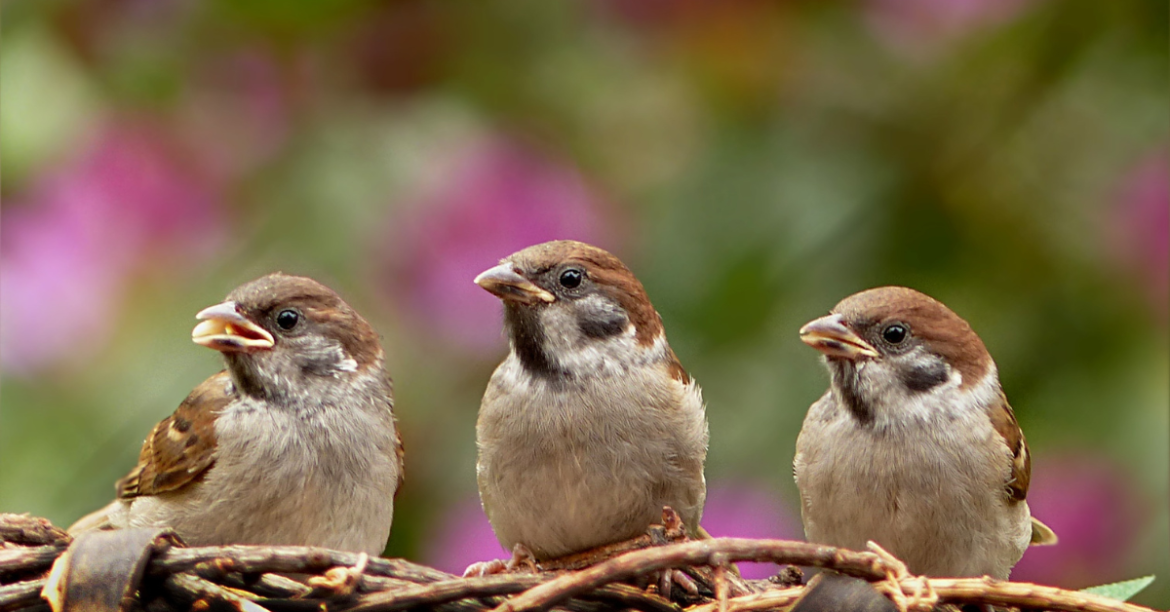Table of Contents
Birds can be charming visitors to your porch, but when they start nesting, they can quickly become a nuisance. Bird droppings, noise, and potential structural damage make it essential to deter them before they settle in. Fortunately, there are humane, effective methods to keep birds from nesting on your porch without harming them. This guide covers 10 proven strategies to bird-proof your porch and keep your outdoor space clean and peaceful.
Why is bird control important? Uncontrolled bird nesting can lead to unsanitary conditions, posing health risks to your family and pets. Birds may also damage structures by pecking at wooden beams or clogging drains and vents with their nests. Taking preventive measures early can save costly repairs and provide a more pleasant outdoor environment.
1. Why Do Birds Nest on Your Porch?
Birds often seek out porches as ideal nesting locations due to the various benefits they offer for safety, shelter, and proximity to resources. Unlike open areas, porches provide a stable, protected environment that shields birds from both predators and harsh weather conditions.
Shelter & Safety: Birds instinctively search for locations that offer protection from predators such as cats, hawks, and other animals. With their overhead covers and enclosed spaces, porches provide an ideal refuge where they feel secure. Additionally, the structure helps shield nests from heavy rain, strong winds, and excessive sun exposure, making it a preferred nesting site.
Readily Available Nesting Materials: Birds prefer areas with easy access to nesting materials. Porches often accumulate twigs, dried leaves, lint, and even human items such as string, fabric scraps, or small pieces of paper. The presence of nearby natural materials and soft debris makes it more convenient for birds to construct nests without traveling long distances.
Proximity to Food Sources: A primary reason birds choose porches is the availability of food nearby. If you have a bird feeder, leave out pet food, or frequently eat outside, birds may be attracted to these easy food sources. Even small food crumbs left on tables or the ground can entice birds to return and eventually settle in.
Overhanging Trees & Ledges: Birds prefer perching spots that offer a good vantage point and a quick escape route. Nearby tree branches, porch beams, light fixtures, and ceiling corners act as natural platforms where birds can land, roost, and later decide to build their nests. Overhanging structures also create a sense of security from ground predators, making them appealing nesting locations.
Reduced Human Activity: If your porch remains unused for long periods, birds may see it as a safe, undisturbed location. Porches with rare human traffic, such as seasonal vacation homes or infrequently used patios, are particularly attractive to birds looking for a low-risk nesting area.
Common nesting spots include roof edges, beams, light fixtures, and ceiling corners. Identifying these spots early helps prevent nesting before it begins.
By addressing these key attraction factors, you can take proactive steps to make your porch less inviting to nesting birds.
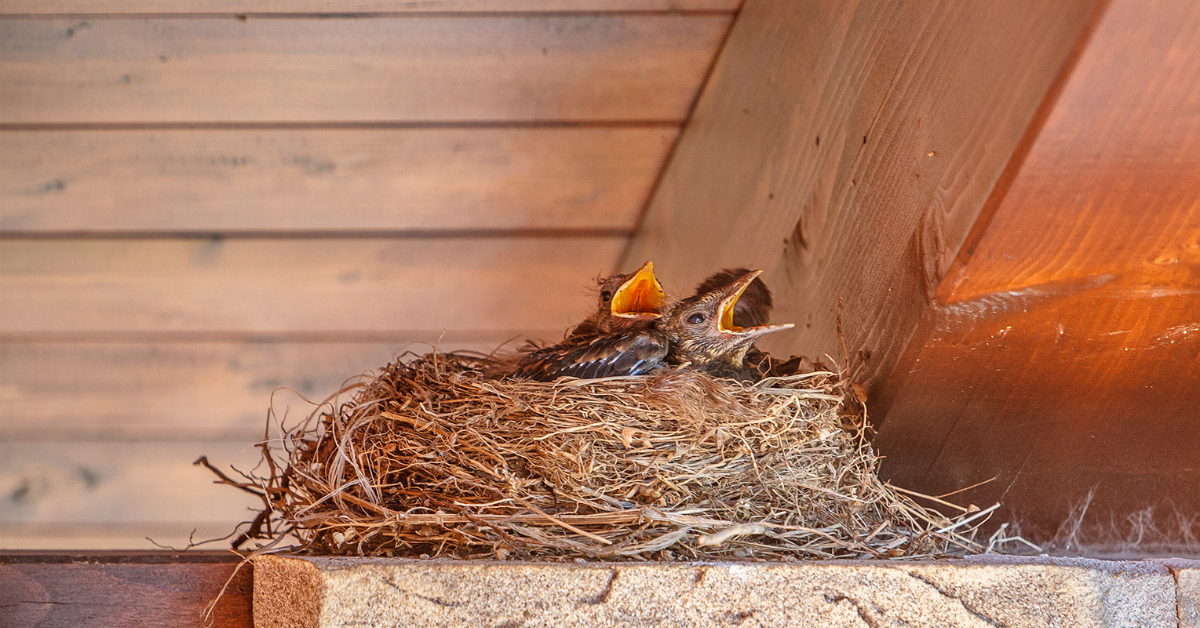
how to keep birds from nesting on your porch.
2. Problems Caused by Birds Nesting on Your Porch
While birds play an important role in nature, nesting on your porch can lead to several issues:
Structural Damage: Nests clog gutters and block air vents, leading to moisture buildup and potential rot.
Health Risks: Bird droppings carry bacteria like Salmonella and fungi such as Histoplasmosis, which can become airborne and affect human respiratory systems.
Pest Infestation: Bird nests attract mites, fleas, and insects, which can spread to your home.
Fire Hazards: Nests in electrical fixtures or vents increase fire risk due to dry nesting materials being highly flammable.
Noise & Aggression: Some birds become territorial and may attack pets or people when defending their nests.
Legal Concerns: Some bird species are protected, making it illegal to remove active nests. Understanding local wildlife laws is crucial.
To maintain a safe and clean home environment, it’s best to take preventive action before nesting begins.
3. How to Keep Birds from Nesting on Your Porch
Here are methods to keep birds from nesting on your porch.
A. Visual & Physical Barriers
1. Reflective Objects
Hang aluminum foil strips, CDs, or reflective tape to scare birds away. These materials create unpredictable light reflections that make birds uncomfortable and deter them from landing.
Use spinning pinwheels or metallic spinners to create movement that disturbs birds. The constant motion confuses birds and discourages them from settling.
2. Fishing Line Trick
Stretch fishing lines tightly along railings or beams to stop birds from perching without hurting them. The thin, nearly invisible line makes it hard for birds to land, keeping them away while keeping your porch looking nice.
Make sure the fishing line is tight and placed just above spots where birds usually sit. This way, they will have trouble landing but won’t get hurt.
3. Bird Spikes
Install plastic or metal spikes on ledges, beams, and railings to block nesting spots. These are humane and effective deterrents for birds, preventing them from roosting without injuring them.
Bird spikes come in different materials and styles, including flexible plastic spikes that can be shaped to fit curved surfaces.
Ideal placement includes window sills, porch railings, roof edges, and light fixtures, areas where birds commonly land before nesting.
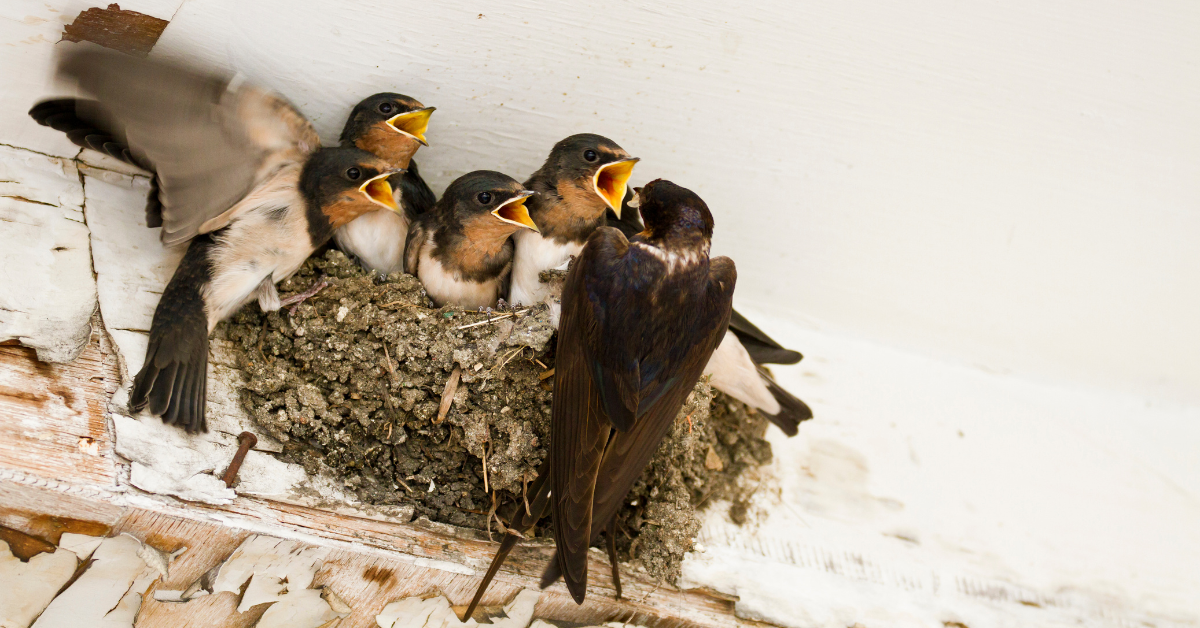
how to keep birds from nesting on your porch.
B. Smell & Taste-Based Deterrents
4. Essential Oil Sprays
Birds dislike strong scents like peppermint, citrus, or cinnamon oil.
DIY Spray: Mix 10 drops of oil + 1 cup water, then spray porch surfaces daily.
Reapply after rain or strong winds for continued effectiveness.
5. Baking Soda
Sprinkle baking soda where birds land, they dislike the texture on their feet. This is a non-toxic method that is safe for children and pets.
Baking soda also helps neutralize odors and absorb moisture, reducing the overall appeal of the area for birds.
C. Sound & Motion Deterrents
6. Wind Chimes or Ultrasonic Devices
Install wind chimes to create noise deterrents. The irregular sound pattern disturbs birds and makes them feel unsafe in the area.
Try motion-activated ultrasonic bird repellents for a high-tech solution that does not disturb humans. These devices emit high-frequency sounds that irritate birds, causing them to avoid the area.
Combine wind chimes and ultrasonic devices for a multi-sensory deterrent strategy that maximizes effectiveness.
7. Motion-activated sprinklers or Lights
Set up motion-activated sprinklers to spray water when birds approach, creating a deterrent effect. Birds dislike unexpected water sprays and will learn to avoid the area over time.
Use solar-powered flashing lights to disturb birds at night without using excess electricity. The sudden bursts of light make the area seem unpredictable and unsafe for nesting.
Consider placing multiple deterrents around your porch to create an unwelcoming environment for birds, reinforcing their reluctance to nest in the area.
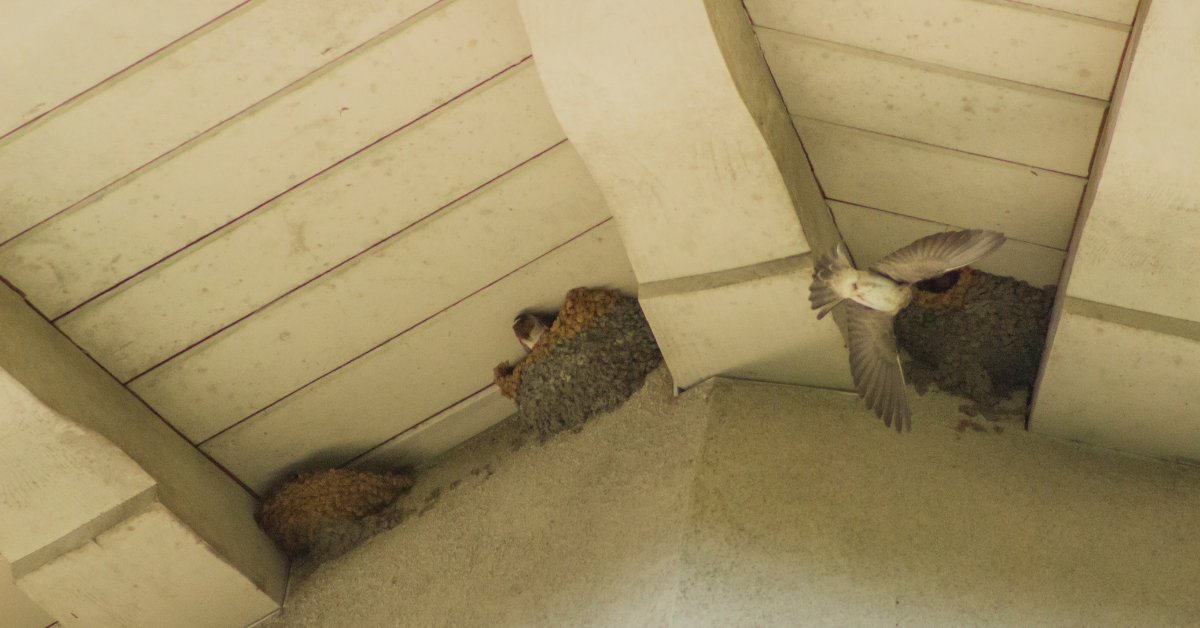
how to keep birds from nesting on your porch.
D. Smart Landscaping & Home Adjustments
8. Trim Trees & Overhanging Branches
Birds love shelter; cutting back trees and overhanging branches near your porch makes it less inviting. This also prevents squirrels and other pests from gaining access to your home, as they often use branches as pathways.
Regular tree maintenance helps improve sunlight exposure, making the area less attractive for nesting birds.
9. Paint Your Porch Ceiling Blue (“Haint Blue”)
Many homeowners believe this tricks birds into thinking it’s the sky, discouraging nesting. This traditional method has been used for generations in the southern United States, particularly on historic homes and porches.
While scientific evidence is limited, many homeowners report success using soft blue shades to prevent birds from settling on ceilings and overhangs.
10. Move Bird Feeders & Water Sources
Place feeders at least 15-20 feet away from your porch to attract birds elsewhere while still enjoying birdwatching at a distance.
If possible, place feeders near dense shrubs or trees to encourage birds to nest in natural environments rather than on your porch.
Avoid leaving out pet food or open garbage, as these can also attract unwanted birds and pests.
4. What to Do If Birds Have Already Nested?
If birds have already built a nest on your porch, it’s important to handle the situation carefully and responsibly to protect both the birds and your home.
Check Local Laws
Some birds, such as swallows and certain migratory species, are federally protected, meaning removing their nests during active nesting can be illegal. Always check with local wildlife agencies before taking action.
Violating bird protection laws can result in fines or legal consequences, so ensure you comply with regulations before proceeding.
Wait Until the Nesting Season Ends
Once the birds have completed their nesting cycle and left, promptly remove the nest to discourage future nesting.
Thoroughly clean the area with a vinegar solution or mild detergent to remove any scent markings that may attract birds back to the same spot.
Consider installing physical barriers, such as wire mesh, to prevent re-nesting.
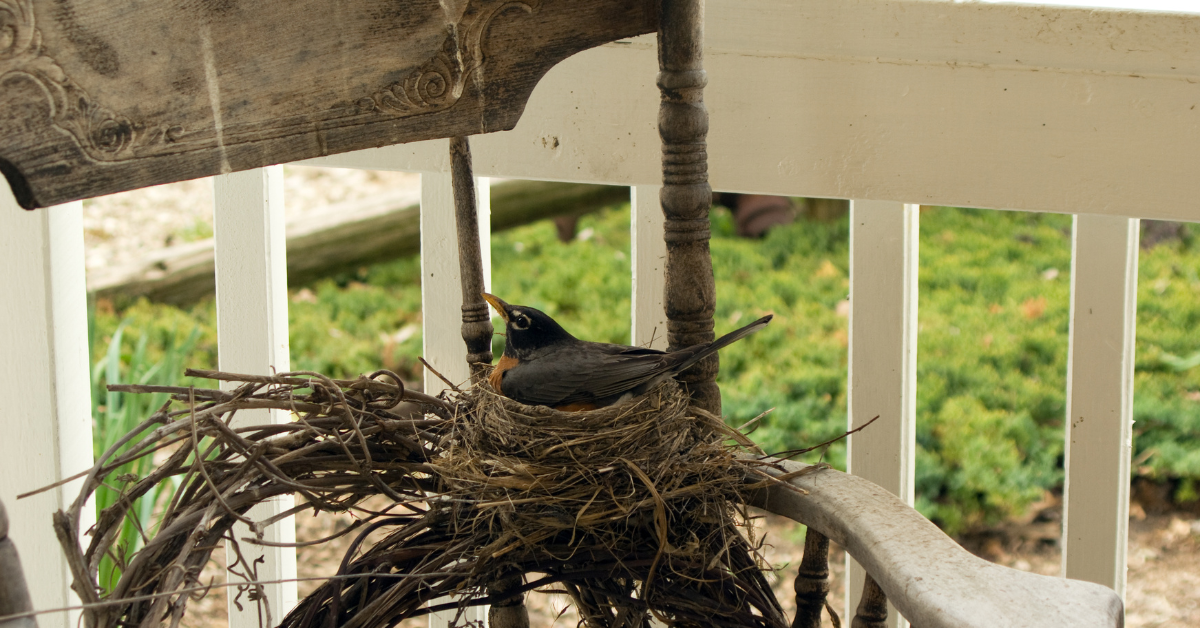
how to keep birds from nesting on your porch.
Use Netting or Covers
After removing an abandoned nest, block off common nesting areas using bird-safe mesh, netting, or plastic covers.
Ensure any barriers are used to allow for proper ventilation while making it difficult for birds to access previous nesting spots.
Cover areas like rafters, eaves, and small crevices where birds tend to build nests, effectively deterring future attempts.
Provide Alternative Nesting Sites
If you enjoy having birds around but want to keep them off your porch, consider placing birdhouses or nesting boxes in safer, more appropriate locations like your garden or backyard trees.
Encouraging birds to nest in designated areas allows you to enjoy their presence without dealing with the mess and damage they might cause on your porch.
By taking these ethical and legal considerations into account, you can safely and responsibly manage bird nesting without harming them while keeping your porch clean and bird-free.
Conclusion
Keeping birds from nesting on your porch doesn’t have to be a constant battle. By using a combination of these 10 proven strategies, you can create a bird-free space without harming them. Whether it’s installing deterrents, using reflective objects, or making small adjustments to your porch setup, consistency is key.
Remember to check for nests regularly, act early, and always choose humane solutions. With the right approach, you can enjoy a clean, peaceful porch while respecting nature.
